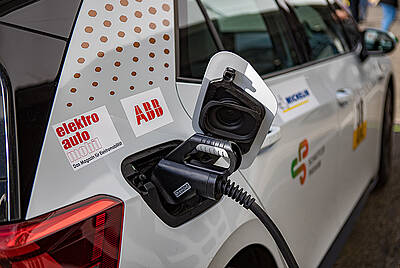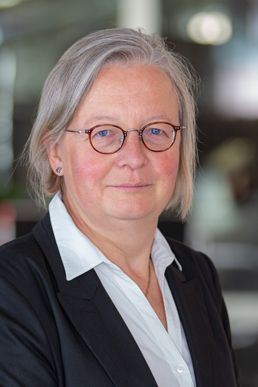The first ADAC 24h-ecompetition on the 4.574 kilometer Grand Prix circuit at the Hockenheimring was less about speed and performance than about efficient energy management or driving style and ultimately range. Team Space Drive of Schaeffler Paravan GmbH & Co KG was at the start with two VW ID3s, each with 58 KWh battery power: The vehicle with the #18 - Team Space Drive 1 - was equipped with the steer-by-wire technology Space Drive, which works without any mechanical connection between the steering unit and the steering gear, analogous to the technology carriers that Schaeffler Paravan uses for development in racing. The Space Drive 2 team with the #19 took part in the competition with a conventional steering system as a reference vehicle. In the end, the #19 narrowly missed out on the podium with a total of 261 laps, while the #18 finished in 6th place after 24 hours and 256 laps.
The VW ID3 with the #18 was piloted by the local heroes Patrick Assenheimer, Jochen Nerpel, Andreas Wirth and Christian Gruber as well as by Michael Pfeiffer, the chief editor of Auto Motor und Sport, who has already successfully completed one or the other record attempt . The second VW ID3 with the #19 was driven by Schaeffler Paravan and PARAVAN employees Wolff Mattuschka, who was also responsible for energy management in the team, Clara Puchinger, Frank Weidner, drifter Alexander Gräff and Timo Haug. Driving skills combined with an intelligently planned consumption and charging strategy determined the success of the race, a challenge for many a professional racer in Team Space Drive 1.
"We drive with Space Drive without a mechanical steering column, via cables with a force feedback steering wheel, and we want to prove here that we can drive through 24h," says Roland Arnold, CEO of Schaeffler Paravan, who developed the system from mobility for the disabled. Such deployments are essential for the system's further development - toward the next generation. "We learned a lot. We were exposed to different weather conditions and were able to extract significant changes from the data collected, which reflected information back to the driver," says Alexander Uphoff, head of system development and responsible for the test vehicles on the road. "These are important impulses for future development, making the system even more robust and reliable."
The first half of the race was a special challenge for the 18 starters of the 24h-ecompetition, which was held in four different classes - with a view to battery capacity. Especially the capricious weather in the evening and at night with squalls and the rain that started later. Starting from eleventh and twelfth on the grid, the cars of Team Space Drive 1 and 2 had a good debut into the race and were able to take the lead of the field in the first hour with starting drivers Patrick Assenheimer and Timo Haug. After a good hour, Team Space Drive 2 returned to the pits for the first loading break and Team Space Drive 1 took the lead until the first pit stop.
"Ready to Load" was then the order of the day in the pit lane: park the car, open the car door, only then did the charging socket on the car open, plug in the cable... After an hour and a half, at around 7 p.m., Michael Pfeiffer climbed into the Space Drive cockpit and drove off into the stormy night. The car is driven according to a sophisticated energy management system: it starts at X percent and reaches charge level Y after just under two hours. The calculation worked out. According to the regulations, the cars could have driven for four hours at the beginning and end of the race, the remaining stints were limited to two hours, followed by a mandatory charge break of about 90 minutes.
The race went through the night without any mistakes. The #18 led the "C" class after Jochen Nerpel's third stint and 104 laps. After the morning hours and the stints of Frank Weidner, Wolff Mattuschka and Timo Haug, the #19 then briefly led the field after 155 laps before heading to the next charge break. "It's difficult to assess at this stage whether it will be enough in the end," says Wolff Mattuschka, responsible for energy management and team leader of Team Space Drive 2. "So far we're on target." In the sixth stint, the #19 was again able to drive to the front of the field. In the morning, the Space Drive Team VW ID3s were on course for a podium finish. But the rivals in the class took their chance and drove four-hour stints again at the end and ultimately came out on top with this strategy.
In the end, Team Tesla Roadster Classic #8 won after 281 laps, with a commanding lead of almost 20 laps, ahead of Team WHB Charging #17 with 262 laps and Team Energy Control #24 with 261 laps. Team Space Drive 2 finished very close behind 2nd and 3rd place, also with 261 laps and 1,194 kilometers, despite the significant differences in battery capacity, which ranged from 52 to 75 KWh for Group "C". Team Space Drive 1 finished in 6th place with 256 laps and 1,171 kilometers. "The differences in power consumption are minimal and also driver-dependent," Mattuschka reported after the race.
Especially for the professionals Patrick Assenheimer, Jochen Nerpel, Christan Gruber and Andreas Wirth, the 24h-ecompetition was a real change. Completely different driving qualities were required here than on the race track. "It was a very interesting experience" all drivers of the #18 agreed. "The steering is very direct, good feedback from the steering wheel, just as I expected," reported Andreas Wirth who was driving Space Drive for the first time. "The differences to the GT3, with regard to steering are actually very small. Only the task was different. In contrast to the race, we make an effort to get off the gas before the apex of the corner in order to generate maximum recuperation," reports Patrick Assenheimer, who has already won trophies at the GTC Race with the Space Drive system.
"You can't drive at full throttle all the time, you have to see that you divide the energy over the distance, which is quite different," Christian Gruber also reports. "You have to pay extreme attention to the load capacity when driving. The strategy plays an absolutely overriding role. Then I was told that I had to stay under 22 KWh. That was a completely different challenge in terms of driving," says Jochen Nerpel, who also used to race cars and is now managing director of Hockenheimring GmbH.
"It was night in my stint, it was cold, it was windy, not easy conditions. Our car kept up well. The Space Drive steering doesn't feel much different," says Auto Motor und Sport Editor-in-Chief Michael Pfeiffer, who participated in this kind of competition for the first time. "If you think about autonomous driving, that at some point the wheels will be steered only by actuator technology, then of course you need a steer-by-wire system, and Schaeffler Paravan is already very, very far along there."
"We develop and test in racing. Our aspiration is to transfer this data that we generate in the individual races to the technology vehicles for the road," says Uphoff. The use of road vehicles is an important building block for the development guideline for Space Drive - From Track to Road. And the event is an ideal testing ground for it. "The technology is the foundation: without steer-by-wire/brake-by-wire, i.e. Space Drive, there will be no autonomous vehicles. Interior concepts can also be completely redesigned - right-left steering is no longer an issue. A mechanical steering column is no longer necessary," Arnold adds. "That's the basis for camera, lidar, sensor manufacturers who depend on secure information transfer and redundant steering system."
About the ADAC 24h e-competition:
At the first ADAC 24h e-competition on February 18-19, electric cars (BEVs) competed against each other for 24 hours. The winner is the team that completes the most laps on the Grand Prix circuit of the Hockenheimring during these 24 hours. At the ADAC 24h e-competition, 100 percent of the cars competing are production cars with fully electric drive. The best strategy leads to class and/or overall victory. A total of 18 teams competed in four vehicle classes.
www.24ecompetition.com









